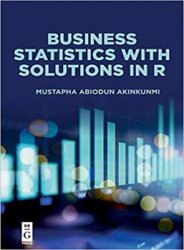 Название: Business Statistics Using R
Название: Business Statistics Using R Автор: Mustapha Akinkunmi
Издательство: De Gruyter
Год: 2019
Страниц: 277
Язык: английский
Формат: pdf (true), rtf
Размер: 10.1 MB
Business Statistics Using R covers a wide range of applications of statistics in solving business related problems. It will introduce readers to quantitative tools that are necessary for daily business needs and help them to make evidence-based decisions. The book provides an insight on how to summarize data, analyze it, and draw meaningful inferences that can be used to improve decisions. It will enable readers to develop computational skills and problem-solving competence using an open source language, R. Mustapha Abiodun Akinkunmi uses real life business data for illustrative examples while discussing the basic statistical measures, probability, regression analysis, significance testing, correlation, the Poission distribution, process control for manufacturing, time series analysis, forecasting techniques, exponential smoothing, univariate and multivariate analysis including ANOVA and MANOVA and more int his valuable reference for policy makers, professionals, academics and individuals interested in the areas of business statistics, applied statistics, statistical computing, finance, management and econometrics.
R is a programming language designed for statistical analysis and graphics. It is based on S-plus which was developed by Ross Ihaka and Robert Gentleman from the University of Auckland, New Zealand. R can be used to open multiple datasets. R is open-source software that can be downloaded free. There are other statistical packages - SPSS, SAS, and Stata - but they are not open source. In addition, there are large R user groups online that can provide real-time answers to questions and that also contribute packages to R. Packages increase the functions that are available for use in R, thus expanding the users’ capabilities.
R can be utilized to develop any statistical analysis. Different types of graphs can be constructed using R statistical software. A range of standard statistical plots such as scatterplots, boxplots, histograms, bar plots, pie charts, and basic 3D plots is provided in R. These basic types of plots can be generated using a single function call in R. The R graphics are able to add several graphical elements together to produce the final outcome. Apart from the conventional statistical plots, R also generates Trellis plots through the package “lattice.” Special purpose plots like lines, text, rectangles, and polygons are also available in the R software. Owing to its generality and feasibility, production of graphical images that are above the normal statistical graphics is possible. This also allows R to generate figures that can visualize important concepts or useful insights. The structure of R graphics has four distinct levels, namely: graphics packages; graphics systems; a graphics engine; and graphics device packages (the full application will be discussed throughout the rest of this book).
Скачать Business Statistics Using R